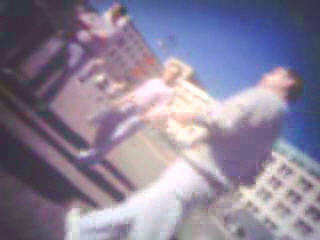
Last year Laszlo Kerekes, a Yugoslavian born artist, transformed a compact digital photo camera with a fixed focus into a dgital pinhole camera by completely removing its lens.
This unusual and technically quite complicated adaptation delivered unexpected photographic results and clearly shows the paradigmatic change from the analogue to the digital mode.

The pinhole camera was already in use during the time of the renaissance and was called the Camera Obscura. The Camera Obscura is a black box with a small hole in the center of its front. The projected image appears upside down in accordance to the laws of physics. The pinhole photo camera is a Camera Obscura built to admit light through a pinhole pierced into aluminum foil to make photographs without a lens:
Of course, analogue and digital pinhole cameras work differently. The analogue camera needs approx. 10 seconds for the exposure, usually resulting in scenes without the presence of people or showing just their ghost-like shadows because they are moving generally much quicker than the time of exposure.
The digital pinhole camera allows a shorter time of exposure. The digital photographs are registered not on film, but on a CCD-sensor, that is, on an electronic chip which has nearly the same size as a single frame of a super 8-mm movie film. The light is shining through an extremely small hole onto the CCD-sensor which reacts very sensitively to any differences of the intensity, quantity or direction of light. Because of these uncontrollable factors, some photographs or some of their parts have a low-level resolution, appearing as if they were images from another planet or even appearing as some ancient daguerreotype. The CCD-sensor is permanently loaded electrostatically, therefore the smallest particles of dust simply cannot be cleaned from its surface. Their presence gives the photographs an extraordinary atmosphere.

Due to the shorter exposure time the digital pinhole camera can also be used as a movie-camera. Laszlo´s camera allows a maximum film duration of 2 minutes, at 10 frames per second.
As with digital pinhole still photographs, the images of the digital wide angle pinhole-movie have special visual qualities, atmosphere and colors. They show a dreamlike reality which cannot be filmed by any other kind of camera. Because of their wide angle, some of the images contain characteristic vignettations, typical for wide angle pinhole shots.
Making movies with a digital pinhole-camera offers a new dimension to the pinhole practice which was unknown until now.
Digital pinhole movies will be screened on next years Directors Lounge 2007, Berlin, 8-18th february. In the meantime you can see two shorts here and here
stills taken from: Movie shot at the Brandenburg Gate in Berlin, October 2006, 57 sec. / without sound.
more about the digital pinhole camera by Laszlo Kerekes and other works
No comments:
Post a Comment